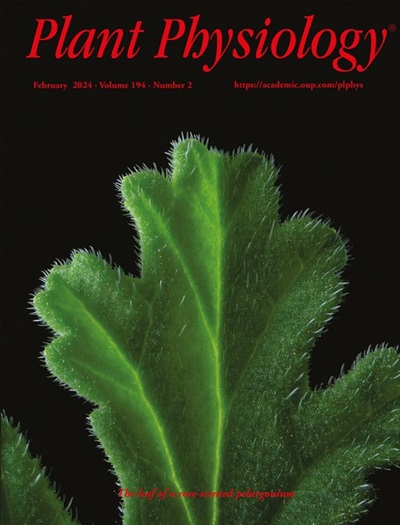A mechanistic integration of hypoxia signaling with energy, redox and hormonal cues
IF 6.5
1区 生物学
Q1 PLANT SCIENCES
引用次数: 0
Abstract
Oxygen deficiency (hypoxia) occurs naturally in many developing plant tissues but can become a major threat during acute flooding stress. Consequently, plants as aerobic organisms must rapidly acclimate to hypoxia and the associated energy crisis to ensure cellular and ultimately organismal survival. In plants, oxygen sensing is tightly linked with oxygen-controlled protein stability of group VII ETHYLENE-RESPONSE FACTORs (ERFVII) which, when stabilized under hypoxia, act as key transcriptional regulators of hypoxia-responsive genes (HRGs). Multiple signaling pathways feed into hypoxia signaling to fine-tune cellular decision making under stress. First, ATP shortage upon hypoxia directly affects the energy status and adjusts anaerobic metabolism. Secondly, altered redox homeostasis leads to reactive oxygen and nitrogen species (ROS and RNS) accumulation, evoking signaling and oxidative stress acclimation. Finally, the phytohormone ethylene promotes hypoxia signaling to improve acute stress acclimation, while hypoxia signaling in turn can alter ethylene, auxin, abscisic acid, salicylic acid and jasmonate signaling to guide development and stress responses. In this Update, we summarize the current knowledge on how energy, redox and hormone signaling pathways are induced under hypoxia and subsequently integrated at the molecular level to ensure stress-tailored cellular responses. We show that some HRGs are responsive to changes in redox, energy and ethylene independently of the oxygen status, and propose an updated HRG list that is more representative for hypoxia marker gene expression. We discuss the synergistic effects of hypoxia, energy, redox and hormone signaling and their phenotypic consequences in the context of both environmental and developmental hypoxia.缺氧信号与能量、氧化还原和激素线索的机理整合
缺氧(缺氧)会自然发生在许多发育中的植物组织中,但在急性洪水胁迫时会成为主要威胁。因此,作为好氧生物,植物必须迅速适应缺氧和相关的能量危机,以确保细胞和最终生物体的存活。在植物中,氧感应与第七类乙烯反应因子(ERFVII)受氧控制的蛋白质稳定性密切相关,当ERFVII在缺氧条件下稳定时,就会成为缺氧反应基因(HRGs)的关键转录调节因子。多种信号通路与缺氧信号传导相互促进,以微调压力下的细胞决策。首先,缺氧导致的 ATP 短缺会直接影响能量状态并调整无氧代谢。其次,氧化还原平衡的改变导致活性氧和氮物种(ROS 和 RNS)的积累,唤起信号传导和氧化应激适应。最后,植物激素乙烯可促进缺氧信号转导,改善急性胁迫适应性,而缺氧信号转导反过来又可改变乙烯、辅助素、脱落酸、水杨酸和茉莉酸信号转导,从而指导发育和胁迫响应。在这篇《最新进展》中,我们总结了目前关于缺氧条件下如何诱导能量、氧化还原和激素信号通路,以及随后如何在分子水平上整合这些通路以确保细胞做出适应胁迫的反应的知识。我们表明,一些 HRGs 对氧化还原、能量和乙烯变化的反应与氧气状态无关,并提出了一个更新的 HRG 列表,该列表对缺氧标记基因的表达更具代表性。我们讨论了缺氧、能量、氧化还原和激素信号的协同效应及其在环境和发育缺氧背景下的表型后果。
本文章由计算机程序翻译,如有差异,请以英文原文为准。
求助全文
约1分钟内获得全文
求助全文
来源期刊

Plant Physiology
生物-植物科学
CiteScore
12.20
自引率
5.40%
发文量
535
审稿时长
2.3 months
期刊介绍:
Plant Physiology® is a distinguished and highly respected journal with a rich history dating back to its establishment in 1926. It stands as a leading international publication in the field of plant biology, covering a comprehensive range of topics from the molecular and structural aspects of plant life to systems biology and ecophysiology. Recognized as the most highly cited journal in plant sciences, Plant Physiology® is a testament to its commitment to excellence and the dissemination of groundbreaking research.
As the official publication of the American Society of Plant Biologists, Plant Physiology® upholds rigorous peer-review standards, ensuring that the scientific community receives the highest quality research. The journal releases 12 issues annually, providing a steady stream of new findings and insights to its readership.
 求助内容:
求助内容: 应助结果提醒方式:
应助结果提醒方式:


